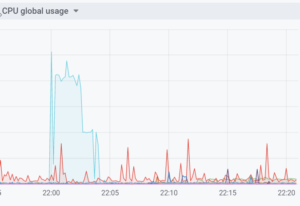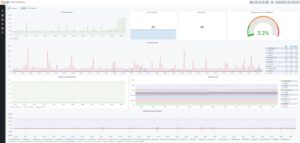I was searching for a good way to get a nice dashboard for my
D ocker Containers. In my first try i made use of a custom component docker_monitor in
ocker Containers. In my first try i made use of a custom component docker_monitor in
Home Assistant. It was working, but sending such a tremendous amount of data to the Home Assistant internal Db that it was growing very fast, which was far from ideal. So i created it in Grafana with help of Telegraf, InfluxDb and made an iFrame in Home Assistant to view the data.
First of all create the InfluxDb container with docker-compose:
influxdb:
container_name: InfluxDB
image: influxdb:latest
restart: always
network_mode: host
ports:
- 8083:8083
- 8086:8086
volumes:
- /home/docker/influxdb:/var/lib/influxdb
labels:
- com.centurylinklabs.watchtower.enable=trueLogin into the docker container by: sudo docker exec -it InfluxDB /bin/bash
Create a new database by running ‘influx’ and then:
CREATE DATABASE DockerDB (or another name)
With ‘SHOW DATABASES’ you can view that the database is created correctly. Type ‘exit’ and another ‘exit’.
Create the Telegraf container with docker-compose:
telegraf:
image: telegraf:latest
hostname: telegraf
container_name: telegraf
depends_on:
- influxdb volumes: - /var/run/docker.sock:/var/run/docker.sock - /home/docker/telegraf/telegraf.conf:/etc/telegraf/telegraf.conf labels: - com.centurylinklabs.watchtower.enable=trueWithin the folder mapping there is an telegraf.conf file, i put in the following content:
# # Read metrics about docker containers
[[inputs.docker]]
## Docker Endpoint
## To use TCP, set endpoint = "tcp://[ip]:[port]"
## To use environment variables (ie, docker-machine), set endpoint = "ENV"
endpoint = "unix:///var/run/docker.sock"
## Only collect metrics for these containers, collect all if empty
container_names = []
## Timeout for docker list, info, and stats commands
timeout = "5s"
## Whether to report for each container per-device blkio (8:0, 8:1...) and
## network (eth0, eth1, ...) stats or not perdevice = true
## Whether to report for each container total blkio and network stats or not
total = false
# Configuration for influxdb server to send metrics to
[[outputs.influxdb]]
## The full HTTP or UDP endpoint URL for your InfluxDB instance.
## Multiple urls can be specified as part of the same cluster,
## this means that only ONE of the urls will be written to each interval.
# urls = ["udp://localhost:8089"] # UDP endpoint example
urls = ["http://127.0.0.1:8086"] # required
## The target database for metrics (telegraf will create it if not exists).
database = "DockerDB" # required
## Retention policy to write to. Empty string writes to the default rp.
retention_policy = ""
## Write consistency (clusters only), can be: "any", "one", "quorum", "all"
write_consistency = "any"
## Write timeout (for the InfluxDB client), formatted as a string.
## If not provided, will default to 5s. 0s means no timeout (not recommended).
timeout = "5s"
# username = "telegraf"
# password = "metricsmetricsmetricsmetrics"
## Set the user agent for HTTP POSTs (can be useful for log differentiation)
# user_agent = "telegraf"
## Set UDP payload size, defaults to InfluxDB UDP Client default (512 bytes)
# udp_payload = 512You can fill in urls and databasefrom your own needs.
At last we create the Grafana container:
grafana:
container_name: Grafana
image: grafana/grafana:latest
restart: always
network_mode: host
ports:
- 3000:3000
depends_on:
- influxdb
- telegraf
volumes:
- /home/docker/grafana:/var/lib/grafana
user: root
labels:
- com.centurylinklabs.watchtower.enable=trueNow you can open your Grafana from Http://yourip:3000 and configure it.
Withtin Grafana create a Import a new Dashboard and choose 1150 af the number.
Choose a folder, a name and your database.
You get a nice Docker Dashboard.

To get is in Home Assistant you will have to edit the grafana.ini witch is in the grafana container. So open up the container by sudo docker exec -it InfluxDB /bin/bash
and give in:
apk update
apk add nano
cd /etc/grafana
nano grafana.ini
edit the following rows:
[auth] disable_login_form = true
......
[auth.anonymous] enabled = true
.......
org_name = JustYourOrgName
.......Reboot Grafana.
Now add the following in Home Assistant:
panel_iframe:
grafana:
title: Grafana
icon: mdi:chart-timeline
url: 'https://theurl-to-the-dashboard'The URL has to be HTTPS if you run Home Assistant in HTTPS. So the best thing to do is create it in Traefik as an url, then it will be HTTPS.

